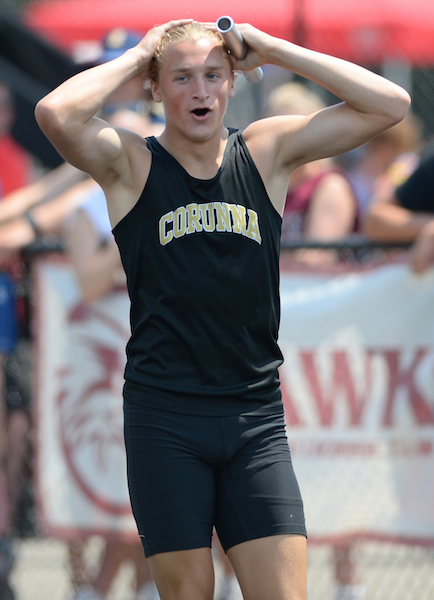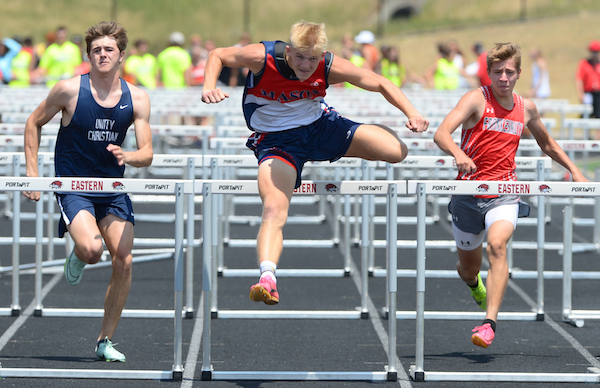
Munising Follows Leaders to Repeat
By
John Vrancic
Special for MHSAA.com
May 31, 2015
KINGSFORD — Senior Andy Cooper and junior Brett Hannah have been the leaders for the Munising boys track team all season.
They continued to lead Saturday as the Mustangs retained their Upper Peninsula Division 3 title with 134 points.
Rapid River brought home the runner-up trophy with 65, with Bessemer and Stephenson sharing third at 45 apiece.
Cooper set U.P. meet records in the 110-meter hurdles in 14.96 seconds and 300 (40.13). He also won the 200 (22.8) and high jump at 6-foot-2, making it two straight seasons with four individual Finals championships.
His effort in the 110 race topped the previous best (15.21) by Grayson Hood of Engadine in 2007. In the 300, he bettered the old standard (40.42) by Mike Schmaus of Ontonagon from five years ago.
Hannah established the 800 record with a personal-best 2:01.45, surpassing the old mark (2:03.41) by Tyler Veraghen of Powers North Central in 2009. He also captured the 1,600 (4:38.09) and 3,200 (10:40.5).
“Getting the PR (and U.P. record) in the 800 felt pretty good,” said Hannah. “It definitely helps to have people from our community come all the way over here and show their support. It’s definitely nice to have that sense of comfort.”
Senior Ben Stasewich added a first in shot put (44-2½).
Munising senior Alex Hill was runner-up in the 100 (11.64) by two hundredths of a second to St. Ignace’s James Cryderman. He also placed second in the 200 (23.95) and third in high jump (5-10). Classmate Austin Kelto was runner-up in long jump (18-5) and Ian McInnis was third in discus (122-7).
Rapid River didn’t get any firsts, but got seconds from junior Dan Blair in the 800 (2:03.2) and 1,600 (4:43.44).
Junior Jon Stropich added a second in pole vault (12-0) and freshman Logan Hardwick was runner-up in discus (125-11).
Rapid River sophomore Mason Berglund was third in the 110 hurdles (17.3) and 300 (44.24).
Bessemer retained its 3,200 relay title and Tim Buerger placed second in the 3,200 (10:51.06) and fourth in the 1,600 (4:58.98). Brayden Tomes was runner-up in the 300 hurdles (44.0) and senior Jess Mazzon placed third in the 400 (54.44).
Stephenson senior Brandon Kau won discus (135-9). Senior Connor Cappaert placed third in the 3,200 (10:58.42), and Tristan Johnson was third in the 100 (11.72).
Crystal Falls Forest Park junior Bill Ragio set the U.P. meet pole vault record at 13-3½, topping the old mark (13-3) by Jimmi Cretens of Rock Mid-Peninsula in 2007. He also took third in the 200 (24.14).
North Central junior Bryce Holle won the 400 (51.78) and placed third in the 800 (2:05).
“I just tried to build up a little speed in practice,” he said. “I did a lot of sprints by doing power line pulls where you sprint one, walk one and jog one (prior to repeating the process). Those seem to help me a lot. Winning the 400 means a lot to me. It’s hard to get good placing when there’s so much competition. The rest of the guys also did a pretty good job.”
Senior J.J. Larson became the first Hannahville athlete to place in the U.P. Finals, taking fifth in discus (114-0).
PHOTO: Munising's Brett Hannah won the 800, 1,600 and 3,200 at the U.P. Division 3 Final on Saturday. (Photo courtesy of Cara Kamps.)

Vicksburg's Wright, Corunna Right On in Claiming LPD2 Championships
By
Steve Vedder
Special for MHSAA.com
June 3, 2023
ADA – If Michael Wright was a baseball player, he probably would've been called out on strikes a year ago.
Instead, the Vicksburg senior can celebrate after winning the 200 at Saturday's Lower Peninsula Division 2 Track & Field Finals at Forest Hills Eastern.
The road to the championship in the 200, via a time of 21.72, was anything but a straight line for Wright. An aspiring baseball player, he was cut from the Vicksburg squad as a freshman. His football career, by Wright's own admission, was "on and off." And then a year ago in his first track meet, Wright suffered a leg injury that virtually ended his season. He did return to finish fifth in the 200 at Finals while helping the 400 relay team to a 16th place.
So there is nothing to realistically explain how Wright found himself in the position Saturday at sweltering Forest Hills Eastern to win a championship. Except for returning this season to break the school record in the 200 four times in two months. Well, that and willpower and simple desire.
 "I knew I could finish high, maybe in the top five. But this is better," said Wright, who credits drinking large quantities of milk for his resurgence. "I looked to football because I didn't think I could bounce back for track. But I overcame the bumps, the obstacles."
"I knew I could finish high, maybe in the top five. But this is better," said Wright, who credits drinking large quantities of milk for his resurgence. "I looked to football because I didn't think I could bounce back for track. But I overcame the bumps, the obstacles."
While Wright was jump-starting his track career, Corunna won the team title with 41 points. Mason and Forest Hills Eastern tied for second with 35. Whitehall was fourth with 33 points, and Frankenmuth fifth with 29 points.
Corunna coach Jeff Sawyer, who had never won a Finals title in 37 years coaching at Owosso and three more at Corunna, said the championship came after little fanfare during the season. Virtually right up until the time Corunna hauled off its first-place trophy, Sawyer said it was never really on his team's mind. The title came after the team managed only a runner-up finish at the Regional.
"We kind of low-keyed it," he said. "We knew scoring 40 points was possible. We lost to Frankenmuth by one point at the Regional. … We were a little disappointed we didn't win, but we had some good times today. We knew it was possible.
"Every day we just come and do what we do. We talk about getting better every day with PRs (personal records). And we're still getting better because we have some tough guys. Just competitive, tough kids. But we were the underdogs."
Corunna had only two firsts on Saturday, in the 400 relay (42.63) and Wyatt Bower in the long jump (22-8½).
Among the individual highlights was Frankenmuth senior Dalton DeBeau, who successfully defended his Finals title in the discus (171-6). He was fifth in that event as a sophomore and after winning a year ago, was considered a good bet to repeat.
"I kind of expected it," said DeBeau, who will compete at Michigan State next spring. "There wasn't a lot of pressure. I knew what had to be done. I threw 160 feet on my first throw to get in the finals, and that helped right away. I knew I could go all out."
 Berrien Springs' Jake Machiniak won the 100 (10.54) while the team also captured the 800 relay (1:28.18). Machiniak said his season hasn't been without its share of difficulties. There was a time when he couldn't seem to come out of the starting blocks smoothly. But beginning with the conference meet where he ran school record 10:73, Machiniak felt himself back on course.
Berrien Springs' Jake Machiniak won the 100 (10.54) while the team also captured the 800 relay (1:28.18). Machiniak said his season hasn't been without its share of difficulties. There was a time when he couldn't seem to come out of the starting blocks smoothly. But beginning with the conference meet where he ran school record 10:73, Machiniak felt himself back on course.
"There were ups and downs. I struggled in the middle of the season," he said. "But my teammates helped me through some difficulties. I came here to finish the job; I knew I could do something here."
Mason's Tyler Baker won the 100 hurdles (14.63) to complete a long journey that included finishing just ninth in last year's prelims. The success was as simple as putting in loads of offseason work.
"I practiced and did stuff about every day," he said. "I might not be the fastest, but I make up for that in form. It's a fine-tuning thing. Everyone wants to be faster."
Mason also got a championship from A.J. Mantel, who captured the 300 hurdles (38.90).
Among other highlights was Forest Hills Eastern senior Aiden Sullivan successfully defending a 2022 title on his own home turf. He won Saturday's 800 (1:53.92).
Adrian won the 3,200 relay (7:39.77), while Grand Rapids Christian took the 1,600 (3:24.49).
Alma had two individual winners in Michael Howey in the shot (55-08) and Jacob Dunlap in the high jump (6-7).
The other champs were Kyle Eberhard of Linden in the 1,600 (4:14.79), Whitehall's Trannon Ayler in the 400 (48.83), Freeland's T.J. Hansen in the 3,200 (9:11.56) and Sam Vesperman of Grosse Ile in the pole vault (15.01). Chelsea senior Jacob Nelson competed in the adaptive 100 (27.28), 200 (57.71) and shot put (6-6).
PHOTOS (Top) Vicksburg's Michael Wright celebrates after winning the 200 on Saturday. (Middle) Corunna's Tarick Bower enjoys a moment after anchoring the winning 400 relay. (Below) Mason's Tyler Baker, center, works to stay ahead in the 110 hurdles. (Photos by Dave McCauley/RunMichigan.com.)

